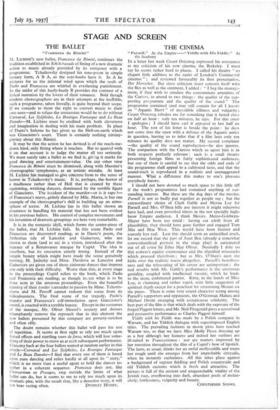STAGE AND SCREEN
THE BALLET
"Francesca da Rimini" M. Lids la's new ballet, Francesca da Rimini, continues the tradition established in Schihirazade of fitting of a new dramatic action to music already provided by its composer with a programme:. Tchaikovsky designed his tone-poem in simple ternary forrn, A A, as the text-books have it: In -A he pictures for us" the infernal wind upon which the souls of Paolo and Francesca are whirled in everlasting punishment. In the midst Of this hurly-btirly B provides -the contrast of a lyrical narration by the lovers 'of their' romance: Bold though modern choreographers are in their attempts at the ineffable, such a programme, taken literally, is quite beyond their scope. If we concede to them the right to convert music to their own uses—and to refuse the concession would be to do without Carnaval, Les Sylphides, La Boutique Fantasque and Le Beau Danube-M. Lichine must be credited with both cleverness and imaginatkin in dealing with his main problem. ' In place of Dante's Inferno he has given us the Hell-on-earth which was Giancicitto's Court. There is certainly nothing niminy- piminy about this Rimini.
It may be that the action he has deVised 'is of the reach-me- down kind; only fitting where it touches. But to quarrel with it on that account is to judge the' matter all too seriously. We must surely' take a ballet as we find "it, giving it marks for good dancing and' entertainment-value. 'On any 'other view Francesca da Rifirini must be dismissed,. along with Massine's choreographic'synaphonies; -an'''artiatie mistake. At least M. Lichine his -initiated to give delikteteform to the sense of horror in Tchaikovsky's music: It is; perhaps, the-horror of a madhouse rather than of Hell that is 'created- by these squirming, writhing dancers, dominated by the terrible figure of Gianciotto. ' The 'incident of the murder—or is it rape ?- of Francesca's nurse, grinilY dthiced by Mlle. -Marra, is but one example of the 'choreographer's skill in building up an atmo- sphere of terror.' M. LiChine 'his in this ballet shown an assurance in handling his material that has not been evident in his previous ballets. His control of complex movements and his invention of dramatic groupings are here very remarkable.
It is in the romantic idyll, which forms the centre-piece of the ballet,. that M. Lichirie fails. In this scene Paolo and Francesca. are disebveied reading, as in Dante's poem, the Arthurian tale of Laneelot and Guinevere, who are shown to them (and to us) in a vision, introthiced 'after the manner of a Renaissanee masque by Cupid:- The idea is excellent, but its execution Utterly wrong. Instead of the simpler beatity which might have Made the scene genuinely moving; jaSinsky- and Mme. Danilova as Lancelot and Guinevere are given one of those eiabbrate dances that impress one only 'with-their difficulty. Worse than this, at every stage in the proceedings Cupid refers to the bobk, which Paolo and FranCesed are reading.; as though to :see what is to be done next . in the amorous proceedings: 'Even the beautiful miming of their tender surrender to passion by Mme. Tcherin cheva and M. "Petroff cannot redeem thiS scene from ' its ridiculousness. . The final scene Of the tragedy, Paolo's murder and Fran:cesca's sel&hrimolation . upon Gianciotto's sword, is enacted with a terrible beauty. Except in the costumes of the masque; . Mr. Oliver Messel's scenery and dresses triumphantly remove the reproach that in this element the new balleti presented by this company are poverty-stricken and often silly.
The doubt remains whether this ballet will pass the test of repetition. It seems at first sight to rely too much upon forced effects and startling tours de force, which will lose some- thing of their rimier to move us at each subsequent performance. Glancing back at the four ballets named at random earlier in this article--Carnaval and Les Sylphides, La Boutique Fantasque and Le Beau Danube—I find that every one of them is based upon pure dancing and relies hardly at all upon its " story," which is no More than a useful agent to hold the dancei to- gether in a coherent sequence. Francesca does not, like Choreartium or Presages, step outside the limits of what ballet can do, but it seems to me .ta rely too ankh upon its dramatic plot, with the result that, like a, detective story, it will






























































 Previous page
Previous page